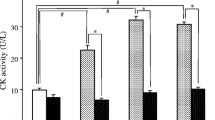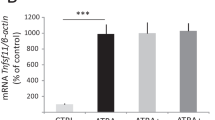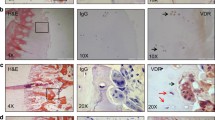Abstract
The effect of menaquinone-7 (MK-7; vitamin K2) on oateoclast-like cell formation and osteoclastic bone resorption in rat femoral tissues in vitro was investigated. The bone marrow cells were cultured for 7 days in a α-minimal essential medium (α-MEM) containing a well-known bone resorbing agent [parathyroid hormone (1–34) (PTH) or prostaglandin E2 (PGE2)] with an effective concentration. Osteoclast-like cells were estimated by staining for tartrate-resistant acid phosphatase (TRACP), a marker enzyme of osteoclasts. The presence of PTH (10–8 M) or PGE2 (10–6 M) induced a remarkable increase in osteoclast-like multinucleated cells. These increases were significantly inhibited by MK-7 (10–8–10–5 M). MK-7 (10–7 and 10–6 M) significantly inhibited phorbol 12-myristate 13-acetate-induced osteoclast-like cell formation, whereas MK-7 did not inhibit dibutyryl cyclic adenosine monophosphate (DcAMP) (10–5 M)-induced osteoclast-like cell formation. These results suggest that the inhibitory action of MK-7 is partly involved in protein kinase C signaling. The bone cells isolated from rat femoral tissues were cultured for 48 h in an α-MEM containing either vehicle or MK-7 (10–8–10–5 M). The presence of MK-7 (10–6 and 10–5 M) caused a significant decrease in the number of mature osteoclasts. Such a decrease was also seen in the presence of calcitonin (10–10–10–8 M), DcAMP (10–6 and 10–5 M), or calcium chloride (10–3 and 10–3 M). The effect of MK-7 (10–6 M) in decreasing the number of osteoclasts was not further enhanced in the presence of calcitonin (10–8 M), DcAMP (10–5M), or calcium chloride (10–3 M), and was completely abolished by the presence of dibucaine (10–6 M) or staurosporine (10–7 M), which are inhibitors of Ca2+-dependent protein kinases. These results suggested that MK-7 has a suppressive effect on osteoclasts. Moreover, the femoral-metaphyseal tissues obtained from rats were cultured for 48 h in Dulbecco's modified Eagle's medium containing either vehicle, PTH (10–7 M), or PGE2 (10–5 M) in the absence or presence of MK-7 (10–7–10–5 M). The presence of PTH or PGE2 induced a significant decrease in bone calcium content. These decreases were significantly blocked by MK-7 (10–7–10–5 M). This study demonstrates that MK-7 has an inhibitory effect on osteoclastic bone resorption in vitro.
Similar content being viewed by others
References
Riggs BL, Melton LJ: The prevention and treatment of osteoporosis. N Engl J Med 329: 620–627, 1992
Bonjour J-P, Schurch M-A, Rizzoli R: Nutritional aspects of hip fractures. Bone (NY) 18: 139S–144S, 1996
Hauschka PV, Lian JB, Gallop PM: Direct identification of the calciumbinding amino acid, ã-carboxyglutamate, in mineralized tissue. Proc Natl Acad Sci USA 72: 3925–3929, 1975
Price PA: Vitamin K-dependent formation of bone gla protein (osteocalcin) and its function. Vitam Horm 42: 65–108, 1985
Hauschka PV, Carr SA: Calcium-dependent α-helical structure in osteocalcin. Biochemistry 21: 2538–2547, 1982
Knapen MHJ, Hamulyak K, Vermeer C: The effect of vitamin K supplementation on circulating osteocalcin (bone gla protein) and urinary calcium excretion. Ann Intern Med 111: 1001–1005, 1989
Hart JP, Sheaver MJ, Klenerman L, Catterall A, Reeve J, Sambrook PN, Dodds RA, Bitensky L, Chayen J: Electrochemical detection of depressed circulating levels of vitamin K1 in osteoporosis. J Clin Endocrinol Metab 60: 1268–1269, 1985
Koshihara Y, Hoshi K, Shiraki M: Enhancement of mineralization of human osteoblasts by vitamin K2 (menaquinone 4). J Clin Exp Med 161: 439–440, 1992
Hara K, Akiyama Y, Nakamura T, Murota S, Morita I: The inhibitory effect of vitamin K2 (menaquinone) on bone resorption may be related to its side chain. Bone (NY) 16: 179–184, 1995
Akiyama Y, Hara K, Ohkawa I, Tajima T: Effects of menatereonone on bone loss induced by ovariectomy in rats. Jpn J Pharmacol 62: 145–153, 1993
Ehara Y, Takahashi H, Yamaguchi M: Effect of vitamin K2 (menaquinone-7) on bone metabolism in the femoral-metaphyseal tissues of normal and skeletal-unloaded rats: Enhancement with zinc. Res Exp Med 196: 171–178, 1996
Sato T, Isobe Y, Ehara Y, Yamaguchi M: Effect of menaquinone-7 purified from the fermented soybean (natto) in the femoral metaphyis from rat femur (in Japanese). Vitamins 70: 317–322, 1996
Yamaguchi M, Taguchi H, Gao YH, Igarashi A, Tsukamoto Y: Effect of vitamin K2 (menaquinone-7) in fermented soybean (natto) on bone loss in ovariectomized rats. J Bone Miner Metab 17: 23–29, 1999
Yamaguhci M, Kakuda H, Gao YH, Tsukamoto Y: Prolonged intake of fermented soybean (natto) diets containing vitamin K2 (menaquinone-7) prevents bone loss in ovariectomized rats. J Bone Miner Metab 18: 71–76, 2000
Tsukamoto Y, Ichise H, Kakuda H, Yamaguhci M: Intake of fermented soybean (natto) increases circulating vitamin K2 (menaquinone-7) and γ-carboxylated osteocalcin concentration in normal individuals. J Bone Miner Metab 18: 216–222, 2000
Tsukamoto Y, Ichise H, Yamaguchi M: Prolonged intake of dietary fermented soybean (natto) with the reinforced vitamin K2 (menaquinone-7) enhances circulating ã-carboxylated osteocalcin concentration in normal individuals. J Health Sci 46: 317–321, 2000
Takahashi N, Yamada H, Yosiki S, Roodman GD, Mundy GR, Jones SJ, Boyde A, Suda T: Osteoclast-like cell formation and its regulation by osteotropic hormones in mouse bone marrow cultures. Endocrinology 122: 1373–1382, 1998
Mundy GR, Roodman GD: Osteoclast ontogeny and function. In: W.A. Peck (ed). Bone and Mineral Research, vol. 5. Elsevier Science Publishers, Amsterdam, 1987, pp 209–279
Burstone MS: Histochemical demonstration of acid phosphatase with naphthol AS-phosphate. J Natl Cancer Inst 21: 523–539, 1958
Minkin C: Bone acid phosphatase: Tartrate-resistant acid phosphatase as a market osteoclast function. Calcif Tissue Int 34: 285–290, 1982
Takada Y, Kusuda M, Hiura K, Sato T, Mochizuki H, Nagao Y, Tomura M, Yahiro M, Hakeda Y, Kawashima H, Kumegawa M: A simple method to assess osteoclast-mediated bone resorption using unfractionated bone cells. Bone Miner 17: 347–359, 1992
Yamaguchi M, Gao YH: Inhibitory effect of genistein on bone resorption in tissue culture. Biochem Pharmacol 55: 71–76, 1998
Yamaguchi M, Oishi H, Suketa Y: Stimulatory effect of zinc on bone formation in tissue culture. Biochem Pharmacol 36: 4007–4012, 1987
Klein-Nulend J, Fall PM, Raise LG: Comparison of the effects of synthetic human parathyroid hormone (PTH)-(1-34)-related peptide of malignancy and bovine PTH-(1-34) on bone formation and resorption in organ culture. Endocrinology 126: 223–227, 1990
Klein DC, Raisz LG: Prostaglandins: Stimulation of bone resorption in tissue culture. Endocrinology 86: 1436–1440, 1970
Sugimoto T, Kanatani M, Kaji H, Yamaguchi T, Fukase M, Chihara K: Second messenger signaling of PTH-and PTHRP-stimulated osteoclast-like cell formation from hemopoietic blast cells. Am J Physiol 265: E367–E373, 1993
Teti A, Colucci S, Grano M, Argentino L, Zallone AZ: Protein kinase C affects microfilaments, bone resorption, and [Ca2+]o sensing in cultured osteoclasts. Am J Physiol 263: C130–C139, 1992
Su Y, Chakraborty M, Nathanson MH, Baron R: Differential effects of the 3′,5′-cyclic adenosine monophosphate and protein kinase C pathways on the response of isolated rat osteoclasts to calcitonin. Endocrinology 131: 1497–1502, 1992
Quinn JMW, Morfis M, Lam MHC, Elliott J, Kartsogiannis V, Williams ED, Gillespie MT, Martin TJ, Sexton PM: Calcitonin receptor antibodies in the identification of osteoclasts. Bone 25: 1–8, 1999
Nicholson GC, Moseley JM, Yates AJP, Martin TJ: Control of cyclic adenosine 3′,5′-monophosphate production in osteoclasts: Calcitonininduced persistent activation and homologous desensitization of adenylate cyclase. Endocrinology 120: 1902–1908, 1987
Zaidi M, Adebarnjo OA, Moonga BS, Sun L, Huang CL-H: Emerging insights into the role of calcium ions in osteoclast regulation. J Bone Miner Res 14: 669–674, 1999
Tamaoki T, Nomoto H, Takahashi I, Kato Y, Morimoto M, Tomita E: Staurosporine, a potent inhibitor of phospholipid/Ca2+-dependent protein kinase. Biochem Biophys Res Comm 135: 397–402, 1986
Vincenzi FF, Godfraind T, Albertini A, Paoletti R: Pharmacology of calmodulin antagonism. In: A. Godfraind, A. Albertini, R. Paoletti (eds). Calcium Modulators. Elsevier Biomedical Press, Amsterdam, 1982, pp 67–80
Yamaguchi M, Sugimoto E, Hachiya S: Stimulatory effect of menaquinone-7 (vitamin K2) on osteoclastic bone formation in vitro. Mol Cell Biochem 2001 (in press)
Author information
Authors and Affiliations
Corresponding author
Rights and permissions
About this article
Cite this article
Yamaguchi, M., Ma, Z.J. Inhibitory effect of menaquinone-7 (vitamin K2) on osteoclast-like cell formation and osteoclastic bone resorption in rat bone tissues in vitro. Mol Cell Biochem 228, 39–47 (2001). https://doi.org/10.1023/A:1013360308946
Issue Date:
DOI: https://doi.org/10.1023/A:1013360308946




